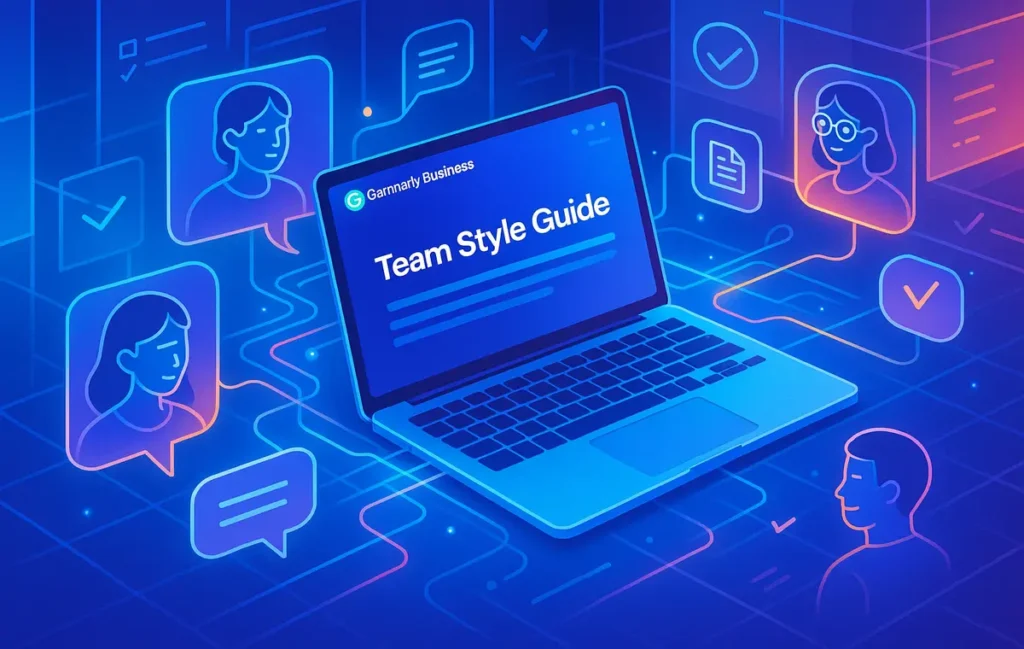🎯 Intro
Every content team faces the same challenge: how do you ensure consistency in writing when everyone has their own style? One team member writes in a casual tone, another leans toward academic formality, and yet another drops emojis into every draft. For individual creators, this is manageable. For brands, it’s chaos.
Enter Grammarly Business, a solution designed to bring cohesion, clarity, and consistency across teams. Instead of just fixing typos, it enforces brand voice, offers centralized oversight, and makes sure your blog posts, email campaigns, and client reports all “sound” like they came from the same place. For teams that care about professionalism and brand identity, this isn’t optional—it’s essential.
While Grammarly Business focuses on teams and enterprises, many professionals start out with the personal version. If you’re curious how the individual tool stacks up today, check our in-depth Grammarly Review 2025: Is the AI Writing Assistant Still Worth It?. That review covers solo use cases, while this article dives into the team-level features that change how entire organizations write.
🔍 What is Grammarly Business?
At first glance, Grammarly Business may look like the premium personal version you’re already familiar with. But the difference is scale and governance. While Grammarly Personal helps individuals clean up grammar, Grammarly Business is built for teams, departments, and entire organizations.
The centerpiece is Style Guides, allowing admins to define rules and guidelines that every team member automatically follows. Think of it as a brand bible that lives inside your editor. Beyond that, the Business version includes user management, analytics dashboards, team reporting, and priority support.
Why does this matter? Because scaling content isn’t just about publishing more—it’s about publishing better. For organizations producing blog posts, scripts, client proposals, or internal documents, inconsistent style chips away at credibility. By using Grammarly Business, teams get a guardrail system that keeps writing on-brand and error-free.
🛠️ Core Features & Deep Dive
The best way to understand Grammarly Business is to break down its main capabilities and what they mean for actual workflows.
📝 Style Guides & Custom Rules
The standout feature. Admins can define brand-specific rules—like using “clients” instead of “customers,” capitalizing certain product names, or banning informal slang. Once set, these rules automatically highlight and correct deviations across your team’s writing. The benefit? Every email, report, and social caption speaks with a unified voice.
Drawback: it requires upfront setup. Defining rules takes time, and overly rigid guidelines can frustrate creative writers. The balance lies in flexibility—establishing enough structure for consistency without suffocating individuality.
💡 Nerd Tip: Use Style Guides not as rigid rules but as living documents that evolve with your brand voice.
👥 Team Management & Roles
Unlike the individual version, Grammarly Business allows centralized user access control. Admins can assign roles (Admin, Editor, Member), monitor usage, and ensure licenses are distributed effectively. For agencies, this helps prevent tools from being underused—or worse, misused.
The tradeoff is complexity. Rolling it out across 50 or 500 users requires training and ongoing oversight. Yet the ROI is huge: brand voice consistency across hundreds of deliverables.
📊 Analytics & Reporting
Managers can track writing trends: Are team members overusing passive voice? Are grammar scores improving over time? Reports can reveal both strengths and training gaps. While some users note reports can lack depth, even basic insights provide a valuable overview for content leads.
💡 Nerd Tip: Use Grammarly reports to spark mini-workshops. Highlight recurring mistakes, then run 15-minute sessions to coach your team.
🔌 Integrations & Plugins
Grammarly Business plugs directly into Google Docs, Word, Slack, WordPress, and even email clients. This means your team isn’t stuck pasting text into a separate app. Instead, corrections and style enforcement happen inside the tools your team already uses.
Occasionally, integrations may cause conflicts—especially in heavily customized CMS setups. Testing compatibility before full rollout is key.
🎧 Support & Enterprise Services
Unlike the free or premium versions, Business users gain access to priority customer support and enterprise-level SLAs. For small teams, this may not feel critical. But for global organizations where downtime means missed deadlines, direct support is a dealbreaker.
📊 Comparison With Competitors
How does Grammarly Business compare to other writing platforms?
-
ProWritingAid Teams: Known for deep stylistic feedback and educational tools, but less intuitive for fast-paced teams.
-
Writer.com: Focused heavily on AI-driven brand voice enforcement, but with steeper learning curves and higher costs.
-
In-house solutions: Some companies develop internal style-checking tools, but they often lack the polish and integrations of Grammarly.
In short, Grammarly Business wins in ease of use and ecosystem integration, while some rivals push harder on customization.
🚀 Deployment Guide for Teams
Rolling out Grammarly Business effectively requires a phased approach:
Step 1: Audit Current Writing Practices. Collect samples from across your organization to identify tone mismatches and recurring errors.
Step 2: Build Your Style Guide. Define the rules and tone your brand demands. Keep it collaborative to ensure buy-in.
Step 3: Train and Onboard. Divide roles and teach your team how to apply corrections without feeling “policed.”
Step 4: Integrate Tools. Enable Grammarly in your key platforms like Slack, Docs, and CMS.
Step 5: Review and Refine. Use analytics dashboards to track progress, then adjust rules as your voice evolves.
This isn’t a one-time setup—it’s an ongoing process of feedback, refinement, and reinforcement.
⚠️ Challenges & Solutions
Adopting Grammarly Business isn’t frictionless. Teams may resist feeling “over-edited,” or struggle with rules clashing against personal writing habits. The solution is cultural: position Grammarly as a helper, not a critic. Encourage feedback loops, update style guides regularly, and allow flexibility where creative freedom is vital.
Scaling is another challenge. Small teams may find the cost high, while large enterprises may struggle with integration. Both cases benefit from piloting first, rolling out gradually, and collecting internal testimonials to prove value.
💡 Nerd Tip: Pair Grammarly rollouts with peer review. Combining AI suggestions with human oversight balances efficiency with empathy.
⚡ Ready to Streamline Your Team’s Writing?
Explore Grammarly Business and unify your brand’s voice across all documents, emails, and campaigns. Start your trial and see how consistent writing drives real results.
💵 ROI & Cost Justification
One of the first objections managers raise when evaluating Grammarly Business is cost. At scale, subscription fees add up quickly. But the real ROI comes from what you save, not just what you spend. Imagine a sales team of 20 people sending dozens of proposals and follow-up emails daily. A single embarrassing typo or an off-brand phrasing in a client pitch can cost a deal worth thousands. Grammarly Business minimizes these risks.
Beyond error prevention, the platform speeds up production. Teams spend less time double-checking tone, grammar, and formatting, which compounds into hours saved each week. For marketing agencies or content-heavy companies, those hours directly translate into reduced turnaround times and higher output capacity. When evaluated against the cost of missed opportunities, the annual fee is often negligible.
💡 Nerd Tip: Calculate ROI not only on reduced errors but also on improved efficiency. Even small time savings across dozens of team members add up fast.
🌐 Cultural Adoption & Change Management
Deploying Grammarly Business isn’t just a technical rollout—it’s a cultural shift. Teams that are used to writing freely may initially see the Style Guide and rule enforcement as restrictive. Resistance is normal. The solution is to frame Grammarly not as a “grammar cop” but as a writing coach that helps everyone improve together.
Leaders should position the tool as a way to support creativity while maintaining consistency. Hosting short workshops or feedback sessions helps normalize its presence. Encourage staff to see Grammarly not as correction but as collaboration—where the AI catches what humans miss, and humans refine what AI suggests. Over time, Grammarly becomes part of the company’s culture, like Slack or project management software.
🔒 Security & Privacy Considerations
For many organizations, the bigger concern is not cost or culture but security. Teams handle sensitive data—client contracts, legal drafts, confidential strategies—and they need assurance that Grammarly won’t compromise them. Grammarly Business addresses this with enterprise-grade security, including data encryption in transit and at rest, SOC 2 Type II compliance, and strict access controls.
While Grammarly stores some anonymized data to improve its algorithms, enterprise accounts can request specific compliance details, including GDPR/CCPA adherence. This is critical for companies in finance, healthcare, and legal industries where confidentiality is non-negotiable. By highlighting these safeguards, Grammarly makes a strong case to security-conscious buyers.
💡 Nerd Tip: Before rollout, involve your IT and compliance teams to review Grammarly’s security whitepapers. Aligning early prevents adoption delays.
🔌 Integration With Productivity Systems
Grammarly Business doesn’t live in isolation—it can be woven into broader productivity frameworks. For example, if your company already uses a knowledge management system like Notion or Obsidian, Grammarly’s Style Guide rules can reinforce how notes and documentation are structured. When paired with productivity systems like How to Set Up a Productivity System That Actually Works or Ultimate Guide to Building a Second Brain, Grammarly becomes part of a larger ecosystem of structured, accessible knowledge.
For teams that run content pipelines, Grammarly complements AI automation tools. Imagine drafting blog posts using AI assistants (like the ones we covered in How to Automate Your Content Workflow with AI Tools) and then running them through Grammarly Business to ensure consistency with your brand voice. This synergy reduces friction and builds confidence that every piece of content—AI-generated or human—meets the same standards.
🔮 The Future of AI in Writing Governance
Grammarly Business today focuses on grammar, tone, and style enforcement. But the trajectory of AI suggests much more to come. In the near future, we can expect real-time voice adaptation—where Grammarly tailors tone depending on the audience (casual for Slack, formal for legal documents). It could expand into compliance enforcement, automatically flagging copy that violates industry regulations or company policies.
For global organizations, multilingual expansion is likely. Imagine a version of Grammarly Business that enforces brand tone across English, Spanish, Mandarin, and beyond—unifying messaging for multinational teams.
At NerdChips, we see Grammarly Business not as a static product but as part of a larger shift toward AI-driven writing governance. Companies that adopt now position themselves ahead of the curve when more advanced features become standard.
Want More Smart AI Writing Insights?
Join our free newsletter and get weekly tips on AI tools, content automation, and productivity systems—delivered straight to your inbox. No fluff. Just value-packed insights for creators and teams.
100% privacy. No noise. Just expert content tips from NerdChips.
🧠 Nerd Verdict
Grammarly Business isn’t just “Grammarly Premium for teams.” It’s a workflow governance system that aligns writing with brand standards, enforces style guides, and provides managers with oversight. For teams that generate high volumes of client-facing or brand-sensitive content, this tool can be transformative.
However, its impact depends on rollout. Without cultural adoption and thoughtful guide-building, it risks being seen as restrictive. With the right approach, it becomes less of a grammar cop and more of a brand ally.
At NerdChips, we see Grammarly Business as an investment in professionalism. If your words represent your brand daily, consistency is priceless.
❓ FAQ: Nerds Ask, We Answer
💬 Would You Bite?
Would your team embrace an AI-powered editor that enforces brand voice—
or would they resist a tool that “tells them how to write”?
Crafted by NerdChips for creators and teams who want their best ideas to travel the world.



